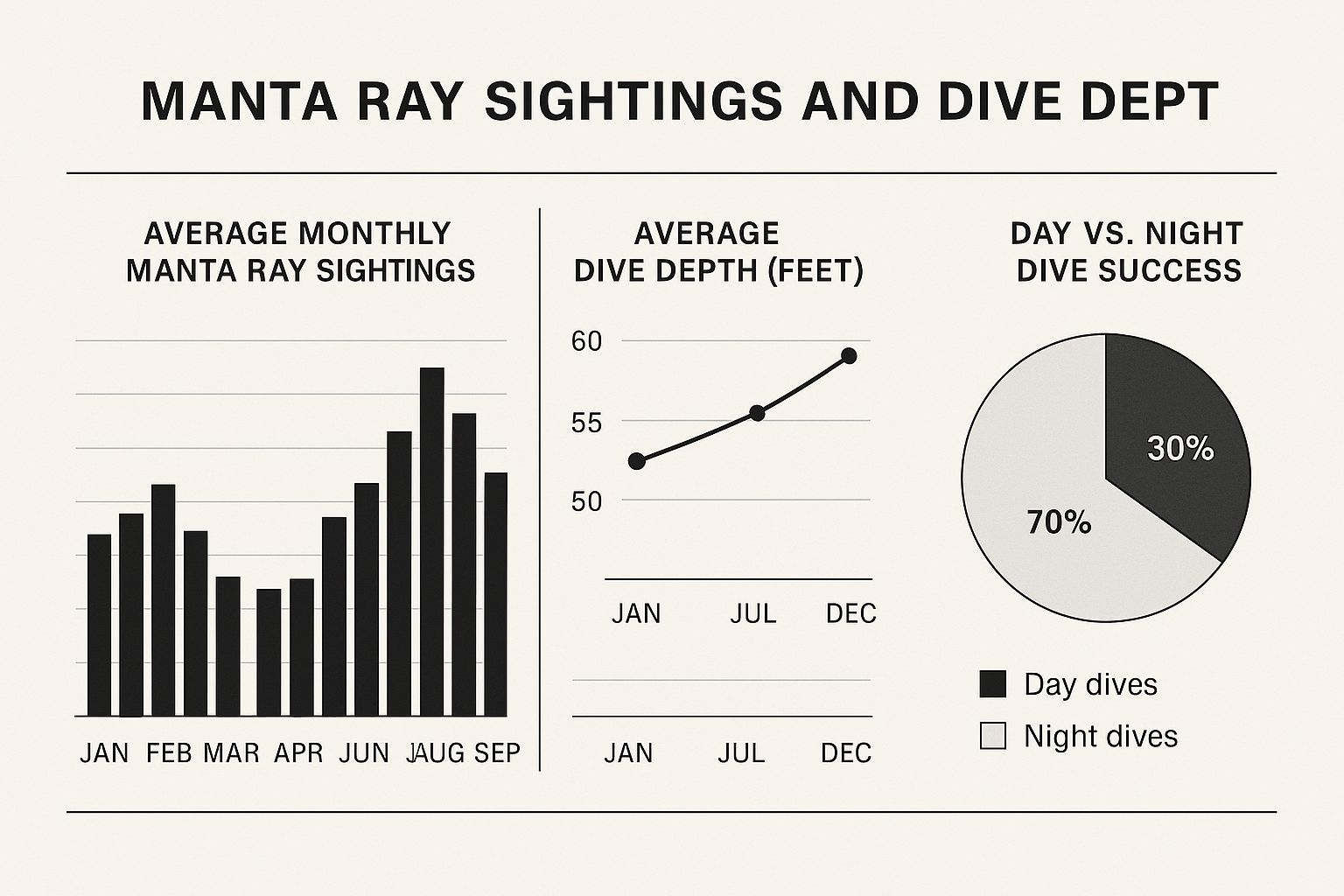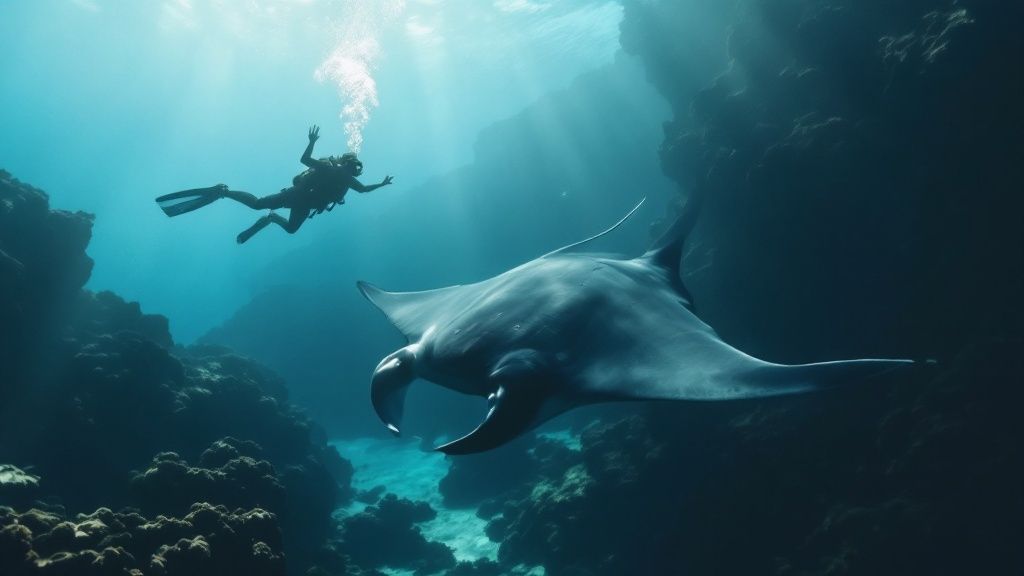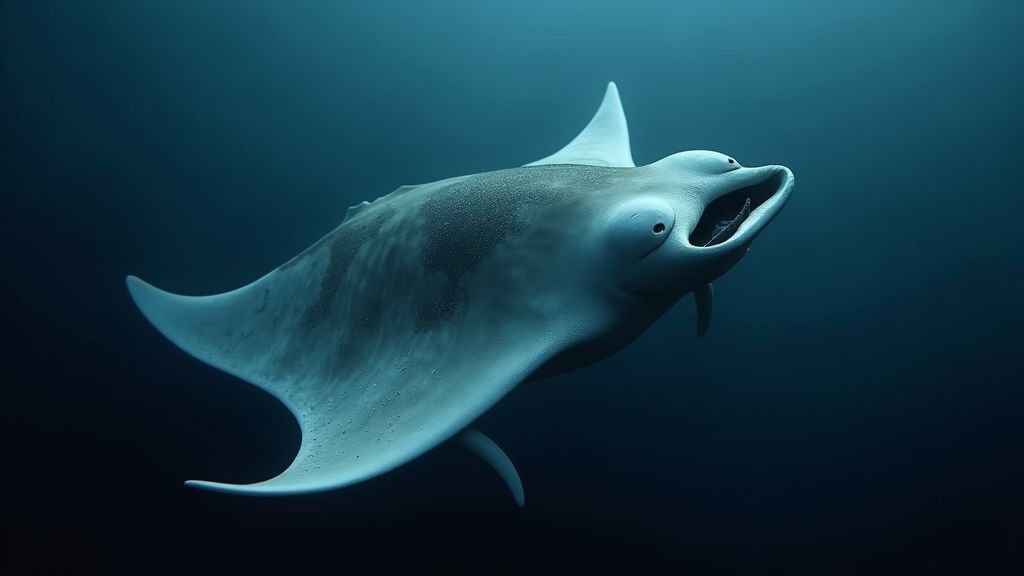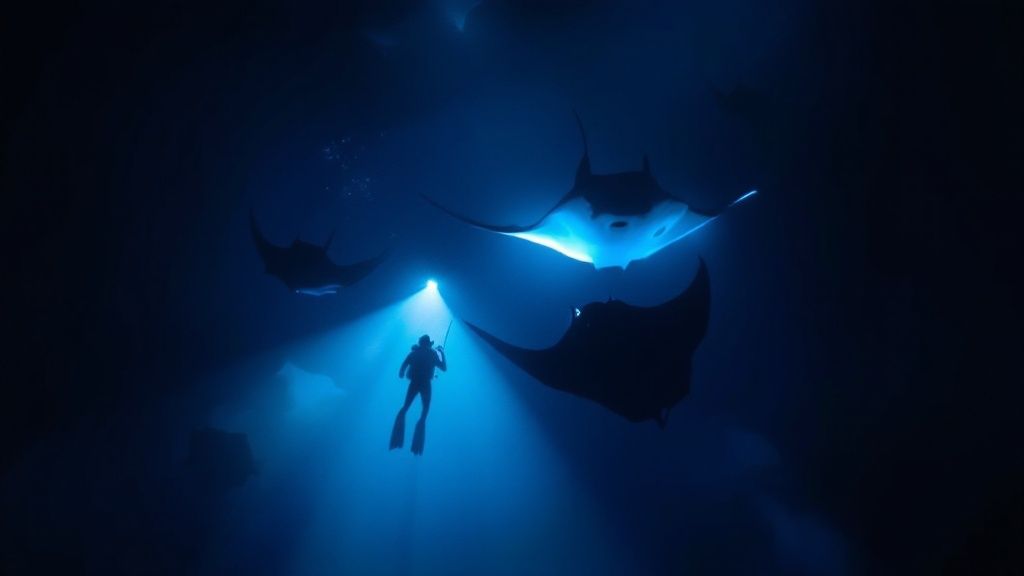Why Kona Is the World's Premier Manta Ray Destination
Kona, Hawaii, is renowned for its breathtaking beauty, but it's also a world-renowned hotspot for manta ray encounters. This isn't by chance. The island's unique geology and oceanography create a perfect haven for these gentle giants. Ancient volcanic activity has sculpted an underwater world of lava tubes and formations, providing ideal habitats and contributing to a rich, diverse ecosystem.
These lava structures offer shelter and contribute to the biodiversity that sustains the entire marine environment. Kona's oceanographic conditions also play a crucial role. Steady water temperatures, sheltered bays, and a consistent supply of plankton—the manta ray's primary food source—create a year-round sanctuary.
This reliable food source, combined with the protective environment, explains why manta rays flourish in Kona's waters. For both novice snorkelers and experienced SCUBA divers, this translates to predictable and safe encounters with these majestic creatures in their natural habitat.
Understanding Kona's Manta Ray Magnetism
To truly grasp Kona's allure for manta rays, let's explore the data. The infographic below visualizes key information about manta ray sightings in Kona: average monthly sightings, average encounter depths, and the success rates of day versus night dives.

As the infographic shows, manta ray sightings remain consistent year-round, with slight increases during certain months. The average dive depths are relatively shallow, making them accessible to divers of varying skill levels. The significantly higher success rate of night dives underscores the unique magic of this experience.
One of the most remarkable aspects of diving with manta rays in Kona is the incredibly high success rate. From 2009 to 2014, Manta Ray Advocates Hawaii documented an 80-90% success rate on dive tours. This consistency, along with the underwater topography and abundant plankton, has cemented Kona's reputation as a top destination for manta ray enthusiasts, drawing approximately 80,000 visitors annually.
To help you plan your manta ray adventure, the following table compares some of Kona's best dive sites:
Manta Ray Dive Sites in Kona
Comparison of the most popular manta ray dive sites along the Kona coast with their unique features and sighting potential
| Dive Site | Location | Best Time | Depth | Experience Level | Sighting Rate |
|---|---|---|---|---|---|
| Manta Village (Keauhou Bay) | Keauhou | Night | 30-40ft | Beginner | Very High |
| Garden Eel Cove | Kona | Night | 20-30ft | Beginner | High |
| Manta Heaven | Kona | Night | 30-40ft | Intermediate | High |
| Airport Beach | Kona | Day/Night | 10-20ft | Beginner | Moderate |
This table provides a quick overview of popular manta ray dive sites, highlighting the best times to visit, typical depths, and the general experience level required. Remember to always dive with certified operators and respect these magnificent animals and their environment. Kona truly offers an unforgettable experience for anyone who ventures into its waters.
The Magical Experience of Night Diving With Mantas

As the sun sets off the coast of Kona, a unique magic unfolds in the ocean. This marks the start of the manta ray night dive, an experience often described as transformative. The adventure begins with a sunset briefing, heightening anticipation as you learn about these incredible creatures. This introduction prepares you for the profound experience that awaits below the surface.
Dancing With Giants in the Dark
Entering the water at night adds a sense of mystery and awe. The darkness heightens your other senses, making the manta rays' arrival even more dramatic. These gentle giants emerge from the depths, their graceful movements illuminated by dive lights. It's a surreal underwater ballet, as they glide effortlessly, often coming incredibly close.
Imagine floating weightlessly in the dark, then suddenly a massive manta ray, with a wingspan wider than you are tall, appears as if from nowhere. These close encounters create a powerful bond between diver and animal, forging a lifelong memory.
The Light and Plankton Attraction
The secret to these close-up views lies in a fascinating technique using light to attract plankton, the manta rays' main food source. Dive operators shine bright lights upward, concentrating plankton in a specific area. This draws the manta rays in, allowing divers to observe their feeding habits up close.
This creates a mesmerizing spectacle as the mantas perform acrobatics, looping and barrel-rolling to maximize their plankton consumption. The cultural significance of manta rays in Hawaiian waters is profound. They are mentioned in the kumulipo, a traditional Hawaiian creation chant. Learn more about manta rays in Hawai'i. The name hāhālua, referring to manta rays, means "two breaths or mouths" in Hawaiian. Beyond their cultural importance, there are two species found in Hawaiian waters: the reef manta ray (Mobula alfredi) and the giant manta ray (Mobula birostris).
Adapting to the Night Dive
Night diving with manta rays in Kona requires some specific equipment adjustments. While standard scuba gear remains the same, divers use dive lights to navigate the darkness and improve visibility. You might be interested in: What is a manta ray night dive?. These lights illuminate the mantas and highlight the vibrant coral reef and other nocturnal sea life. Many divers opt for underwater cameras with external flashes to capture these stunning nocturnal encounters, sharing the experience and contributing to our understanding of these magnificent creatures.
Meet the Mantas: Kona's Remarkable Underwater Residents

A manta ray dive in Kona, Hawaii, isn't just about passively watching wildlife. It's about forging a connection with these intelligent, gentle giants. Kona offers a rare opportunity to encounter manta rays as individuals, each with their own distinct personalities and captivating stories. These aren't fleeting glimpses of anonymous creatures; they're meetings with recognizable, unique beings.
This personal touch transforms a simple dive into an unforgettable, meaningful experience.
Kona's Manta Ray Celebrities
The Kona manta ray community has its own cast of characters. From the impressive 16-foot "Big Bertha" to the playful "Koie," every manta possesses a unique pattern of markings on their belly. Like fingerprints, these markings allow researchers to track individuals across decades.
This long-term monitoring has revealed surprising insights into their lives. For instance, extensive manta ray research in Kona has identified over 290 unique individuals, starting with the first recorded manta, aptly named Lefty. This ongoing cataloging underscores Kona's significance as a crucial research hub.
Unlocking Manta Mysteries Through Research
By studying individual mantas, scientists are gaining invaluable knowledge about their intelligence, social structures, and lifespan. These dedicated studies are revealing complex behaviors and intricate social interactions within manta ray populations. This deeper understanding is instrumental in developing successful conservation strategies.
Every manta ray dive in Kona contributes to our growing understanding of these fascinating animals.
Citizen Science: Your Role in Manta Conservation
Visitors can play an active role in ongoing manta ray research through citizen science initiatives. By simply taking photographs of manta ray bellies during your dive, you can assist researchers in identifying and tracking individuals.
This collective effort contributes valuable data points to long-term studies. This hands-on involvement adds another dimension to the already enriching manta ray dive experience.
Fostering Deeper Connections
The ability to recognize individual mantas cultivates a deeper appreciation for these majestic creatures. Knowing a manta's name and history makes each encounter more personal and impactful. This fosters a profound connection with marine life, inspiring respect and a desire to protect these incredible animals.
These personal encounters are often described as life-changing, transforming a simple dive into a truly profound and memorable experience.
Planning Your Perfect Manta Ray Dive in Kona

Planning a manta ray dive in Kona is essential for an unforgettable experience. This means carefully considering several key factors, including the best time to visit, choosing a reputable tour operator, and having the right equipment. A well-planned dive will ensure a smooth, enjoyable, and memorable encounter with these majestic creatures.
Choosing the Right Time and Operator
While manta rays grace Kona's waters year-round, certain months offer increased sighting opportunities. Researching these peak seasons, typically summer and fall, can greatly enhance your chances of a truly breathtaking encounter. Choosing the right dive operator is equally crucial.
Look for operators with experienced guides, a strong emphasis on safety, and excellent reviews. The right operator can significantly elevate your comfort and overall dive enjoyment. They can also offer valuable insights into manta ray behavior and the local ecosystem.
To experience these gentle giants from a different perspective, a dedicated Kona snorkel adventure is also a great option. Manta Ray Kona Snorkel offers a unique way to connect with these incredible animals.
Equipment and Preparation: Ensuring a Smooth Dive
Having the correct equipment is fundamental to a successful manta ray dive. If you're new to diving, researching basic scuba gear or even freediving equipment is recommended. Proper equipment ensures your safety and allows you to fully immerse yourself in the experience, focusing on the wonder of the mantas.
Preparing yourself physically is also important. This could involve practicing basic swimming techniques and getting comfortable in the water. Adequate physical preparation can prevent discomfort and enhance your overall dive experience.
Managing Pre-Dive Jitters: Tips for First-Timers
For first-time night divers, pre-dive anxiety is perfectly normal. However, there are ways to manage these feelings. Deep breathing exercises and visualization techniques can be highly effective in calming nerves and promoting relaxation. Discussing any concerns with your dive guide can also provide reassurance and build confidence.
To further prepare and understand what to expect, you can watch videos of previous manta ray night dives, allowing you to visualize the experience and ease any apprehensions.
Before we discuss accommodation and itinerary planning, let's compare some of the top manta ray dive operators in Kona:
To help you choose the perfect tour, here's a comparison of some reputable operators:
Manta Ray Dive Operators Comparison:
Detailed comparison of the top manta ray dive operators in Kona with their offerings, prices, and unique features.
| Tour Operator | Group Size | Experience Required | Price Range | Tour Duration | Special Features | Reviews Rating |
|---|---|---|---|---|---|---|
| Big Island Divers | 6-8 | None | $150-$200 | 2-3 hours | Underwater photography, small groups | 4.8 stars |
| Kona Honu Divers | 4-6 | Beginner | $175-$225 | 3 hours | Personalized experience, marine biologist guide | 4.9 stars |
| Manta Adventures | 10-12 | None | $125-$175 | 2 hours | Large boat, affordable option | 4.5 stars |
| Jack's Diving Locker | 8-10 | Open Water Certification | $160-$210 | 2.5 hours | Experienced guides, multiple dive sites | 4.7 stars |
Note: This table represents example data and should be updated with real information from local dive operators.
This table provides a quick overview of different operators, allowing you to compare group sizes, experience requirements, pricing, and special features to find the best fit for your needs.
Accommodation and Itinerary Planning: Beyond the Dive
Choosing accommodation near the manta ray dive departure points can streamline your experience. This minimizes travel time and maximizes convenience. Integrating your manta ray dive into a broader Big Island itinerary is also a great idea.
This could involve exploring other attractions, such as Volcanoes National Park, or simply relaxing on Kona's beautiful coastline. A balanced itinerary blends adventure with relaxation, creating a truly memorable Hawaiian getaway. By carefully considering these planning aspects, your manta ray dive in Kona will undoubtedly be an extraordinary experience.
Conservation and Responsible Manta Tourism
Your manta ray dive in Kona offers more than just a personal thrill. It's a chance to contribute to the conservation of these incredible animals. The collaboration between tourism and conservation in Hawaii is truly special, with local operators and marine conservationists working hand-in-hand to ensure the well-being of these gentle giants for future generations.
Threats to Manta Rays and Kona's Conservation Model
Manta ray populations face numerous challenges, including fishing pressure, entanglement in fishing gear, the effects of climate change, and habitat degradation. Kona's community-based conservation model stands as a shining example of how to effectively protect these vulnerable animals. It emphasizes a collaborative approach between researchers, tour operators, and the local community.
Many tour operators contribute a portion of their profits to research and conservation initiatives. They also play an active role in educating visitors about responsible manta ray interaction. This education emphasizes passive observation and minimizing any disturbance to the mantas' natural behavior. This concerted effort has helped position Kona as a global leader in manta ray conservation.
Protective Regulations and Ongoing Research
Hawaii has established protective regulations for manta rays, including restrictions on fishing and how people can interact with them. These regulations, coupled with ongoing research partially funded by tourism, have created a safer haven for these magnificent creatures. Researchers are continually expanding our knowledge of manta ray behavior, migration patterns, and the impacts of human activity.
This valuable research informs conservation strategies and helps ensure that tourism remains sustainable and doesn't negatively impact the mantas. For more detailed information on this topic, take a look at our article on Hawaii's manta ray rules and regulations. The data gathered through this research also helps assess the long-term health of the manta ray population and allows for adjustments to conservation efforts as needed.
Your Role in Responsible Manta Tourism
You can actively participate in manta ray protection during your Kona dive. Before you even enter the water, familiarize yourself with responsible manta ray viewing guidelines. These guidelines typically include maintaining a safe distance from the animals and absolutely avoiding touching them. During your dive, carefully follow your guide’s instructions and respect the mantas' space.
After your dive, consider supporting local conservation organizations. Sharing your experience with others can also raise awareness about the importance of manta ray protection. Educated visitors often become passionate advocates for marine conservation, even after they've returned home. By making thoughtful choices and supporting responsible tourism, you directly contribute to the preservation of these remarkable animals and their unique habitat.
Beyond the Dive: The Complete Manta Ray Experience
Your manta ray dive in Kona is undoubtedly a highlight of any Hawaiian adventure. But the experience doesn't have to end when you surface. Extend your journey and deepen your connection with these graceful creatures and Hawaiian marine heritage. Explore the numerous opportunities Kona offers beyond the dive itself. Transform a single dive into a richer, more meaningful experience that resonates long after you leave.
Educational Encounters: Learning More About Mantas
One way to enhance your manta ray experience is to engage with local experts. Consider visiting the Manta Learning Center, where marine biologists share their knowledge and passion for these remarkable animals.
Participating in manta identification workshops provides a deeper understanding of the research process. You’ll learn how to recognize individual mantas based on their unique markings, contributing to ongoing studies.
Additionally, attending evening presentations by researchers offers fascinating insights into the latest manta ray discoveries. These presentations often cover topics ranging from manta ray behavior and migration patterns to the challenges they face in a changing environment.
Community Engagement and Conservation Efforts
Beyond formal learning environments, Kona’s community offers various ways to connect with manta rays. Local events often support conservation initiatives. For example, some organizations host fundraising events that directly benefit manta ray research and protection efforts. When thinking about responsible manta tourism, it’s interesting to consider cultural attitudes towards alcohol consumption elsewhere. For instance, you can learn about South Korean drinking culture.
Supporting local artists whose work celebrates these gentle giants is another way to connect with Kona’s manta ray culture. Many local artisans create stunning artwork inspired by the beauty and grace of manta rays. Purchasing their work not only provides a unique souvenir, but also supports the local community and its artistic expression.
Expanding Your Ocean Exploration
Complement your manta ray dive with other ocean activities that enhance your understanding of Hawaii’s vibrant marine ecosystem. Consider exploring the coral reefs through snorkeling or diving during the day. Whale watching tours are another fantastic option, offering a chance to witness humpback whales during their migration season.
These experiences provide a broader perspective on the interconnectedness of marine life and the importance of ocean conservation. By participating in a range of ocean activities, you gain a deeper appreciation for the delicate balance of Kona’s marine ecosystem.
Creating a Lasting Impact
By immersing yourself in Kona’s manta ray culture beyond the dive, you’ll gain a profound appreciation for the cultural, ecological, and personal significance of these remarkable creatures. The memories you create will extend far beyond a single dive, fostering a lasting connection with the ocean and inspiring you to become a steward of marine life.
Ready to dive into the incredible world of manta rays in Kona, Hawaii? Book your unforgettable adventure with Kona Honu Divers today and experience the magic firsthand! Discover the Kona Honu Divers Experience
